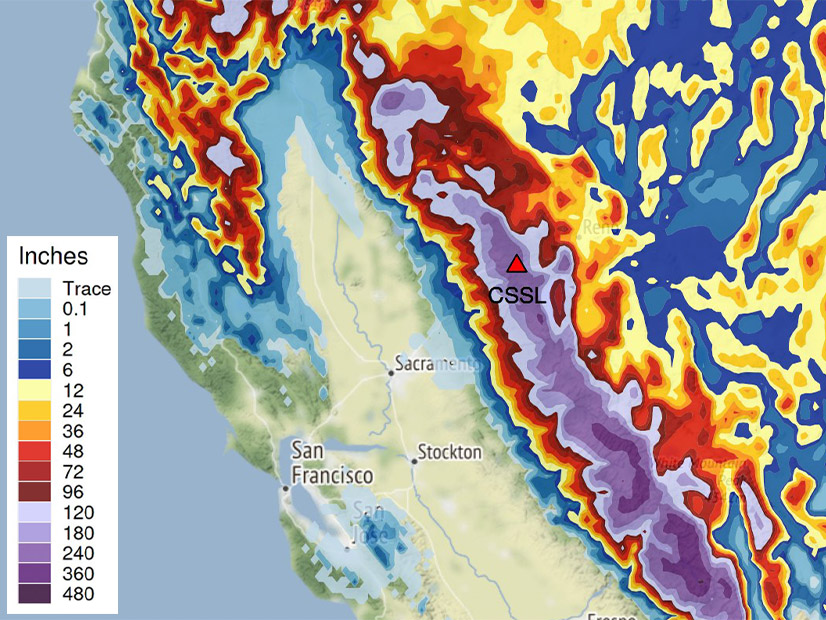
SACRAMENTO, Calif. — After three weeks of torrential rains and high winds from a series of atmospheric river storms, California started to dry out Tuesday, with sunny skies forecast for at least the next 10 days.
The storms that began Dec. 26 caused widespread flooding and power outages as winds toppled thousands of power poles and trees. They also refilled hydroelectric reservoirs severely depleted from three years of drought and built snowpack in the Sierra Nevada that in some areas is nearly 300% greater than normal for this time of year. The state relies on that snowpack as it melts during the dry months from May to October for hydroelectric generation, farming and residential use.
In San Francisco, which bore the brunt of the storms as they flowed in succession from the central Pacific, more than 18 inches of rain fell since Dec. 26, making it the “wettest 22-day period since January 14, 1862,” the National Weather Service said. (The prior record-holding period was known as the Great Flood of 1862, when weeks of January rains caused rivers to overflow their banks from northern Oregon to Southern California.)
In the Sacramento area, at least 599,000 customers lost power as 1,800 power lines were downed in the 10 days after New Year’s Day, the Sacramento Municipal Utility District reported. The four storms that hit during that period were the most damaging string of storms in the utility’s 100-year history, with the “largest mobilization of personnel and restoration crews ever,” SMUD said. More than 300 power poles were toppled — each of which takes a full crew eight hours to replace — and 650 trees fell or broke, SMUD said.
“Due to extensive damage, many customers have experienced lengthy outages that last overnight, and some will last several more days,” the utility said in a Jan. 10 news release. “SMUD has been contacting vulnerable customers we expect to be out of power overnight directly so they can make arrangements.”
Pacific Gas and Electric also said it mobilized its largest storm response in company history to restore power to 1.6 million customers who lost power in the first two weeks of January.
“PG&E has more than 5,000 dedicated personnel currently responding to the storm, including contractors and mutual aid from Southern California, Canada, Colorado, Idaho, New Mexico, Oregon, Utah, Washington, Wisconsin and Wyoming, with additional resources expected to arrive and assist in the coming days,” the utility said in a Jan. 9 statement. “Hundreds of PG&E employees are serving in the company’s Emergency Operations Center as well as in regional and divisional emergency centers.”
Flooding in low-lying areas and the threat of mudslides in coastal hills led to evacuations in Sacramento County and Santa Barbara County, respectively, while the Monterey Bay area was pummeled by huge waves and nearly cut off from the rest of the state by swollen creeks and rivers.
President Biden plans to visit storm ravaged areas Thursday, following his issuance of a major disaster declaration for six counties.
In addition to destruction, the storms brought badly needed precipitation to California after three years of drought that undercut hydropower, adding to the state’s summer resource shortfalls and near blackouts.
Lake Oroville, the state’s second-largest hydroelectric reservoir with more than 3,500 acre-feet of capacity, had filled to 105% of its historical average for the date Tuesday and stood at 58% of capacity. Two weeks ago, the lake held 74% of its historical average and 39% of its capacity. It had run so dry in the drought that generation ceased in July 2021 for the first time since Oroville Dam was built in the 1960s.
Eight of the other major reservoirs operated by the state Department of Water Resources (DWR) had filled to their historical averages on Tuesday after years of depletion. Seven others that remained below average included Lake Shasta, the state’s largest man-made reservoir with a capacity of 4,552 acre-feet. But the lake had refilled to 84% of its historical average and 53% of its capacity; two weeks ago, it was at 57% of its historical average and 34% capacity.
Snowpack numbers were even more impressive. After three years of nonexistent or quickly vanishing snowpack, much of the Sierra Nevada Mountain range was buried in 30 feet of snow. The Northern Sierra had 202% of the region’s historical average snowpack on Wednesday; the Central Sierra had 253%; and the Southern Sierra had 292%, DWR reported.
All three areas already had met or exceeded 100% of average snowpack for April 1, a key date in state water planning for summer. The Southern Sierra had 148% of average snowpack for April 1, and the Central Sierra had 128% of average.
On a Jan. 10, the U.S. Drought Monitor removed much of the state from “extreme” and “exceptional” drought conditions, which had persisted through December. Moderate and severe drought still grips most of California.
Whether the snowpack lasts until it’s needed in the dry months remains in question. After a wet December 2021, 2022 saw the driest January-March period on record. State water officials have warned that more storms are needed to ensure an adequate water supply this year.